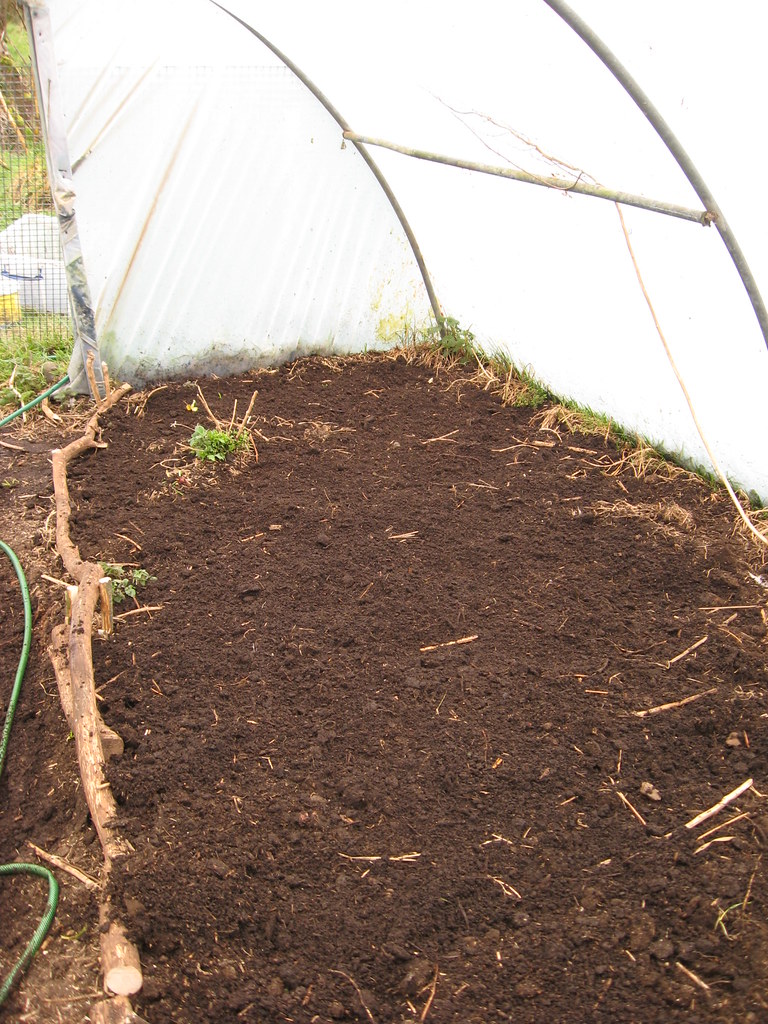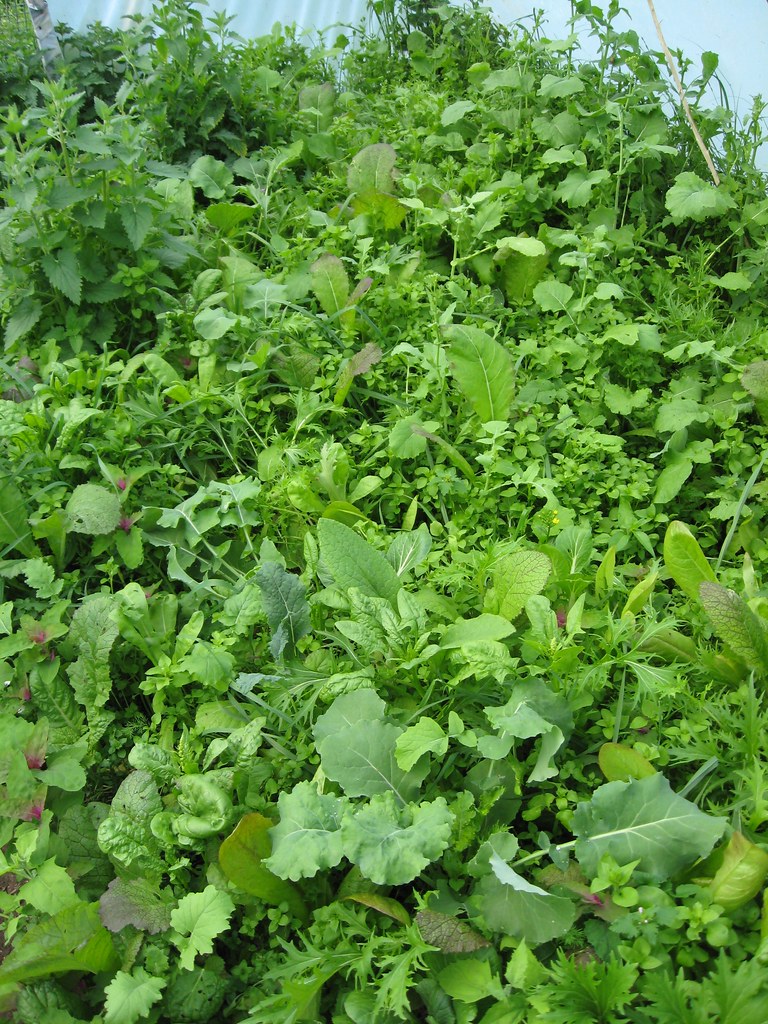


|
Commenced:
|
01/01/1995 |
|---|---|
|
Submitted:
|
24/05/2012 |
|
Last updated:
|
15/10/2021 |
|
Location:
|
Clogher, Kilfenora, Co. Clare, IE |
|
Climate zone:
|
Cool Temperate |
(projects i'm involved in)
Project: Sailchearnach
Posted by Ute Bohnsack about 13 years ago
Inspired by Toby Hemenway's description of Ianto Evans's
Polyculture in "Gaia's Garden" I am trying it this year, albeit in our
polytunnel. We are in the West in Ireland and this spring it has been
unusually cold, except for a very warm spell in the week before Easter.
It was still unseasonally cold until mid-May with temps dropping below zero most
nights, even in the polytunnel. During the day, when there is good sun,
the temps can go up to 40C, so quite a challenge for the little plants. I
water every second day.
On April 2 I sowed an area of about 40 square feet
*Pot Marigold
*Lettuces Cimmaron, Marvel of the Four Seasons, Bath Island (Cos), Crisp Mint Lettuce (Cos/Romaine), Rouge d'Hiver (Romaine)
*some Salad leaves Stir Fry Mixed (Mizuna, Kanton Pak Choy, Red Mustard, Texel Greens, Cavolo Nero=Tuscan kale)
*Radish, Oriental Rosa 2 (Ostergruss) + Cherry Belle
* Spinach Bloomsdale Long Standing
* Dill
* Parsnip Bedford Monarch
I also threw in a few seeds of Ragged Jack Kale.
The soil is drained fen peat, so very rich in organic matter, great
gardening soil. I had a dozen or so young roosters in the polytunnel
over the winter to clear it out, manure it, and eat slugs etc. so the
soil is nice and fertile. I never dig the soil in there, just pull weeds
and loosen it a bit.
This is on Apr. 2. The 2 existing plants on the left side of the bed are Shungkiku (Chrysanthemum coronarium) and Korean Mint (Agastache anisata).

Then my camera broke...
Germination started after about a week and after a month I could begin harvesting bits and pieces. It's become a dense carpet of greens. There are plenty young lettuces, a good bit of Mizuna, leaf mustard, spinach and Pak Choy. We started getting a daily little bowl of mixed leaves, young lettuce plants and a few radishes. There is also a bit of self-seeded borage coming up.
One little "problem" I have, if you want to call it that, is volunteers:
1) Chickweed: A thick carpet of it coming up, crowding and shading
the other young plants. It comes back year after year as the seeds are
so tiny that the chickens don't find them. I know its edible and
nutritious but tastewise it wouldn't be my favourite green. I pull it
for the chickens but it takes a good bit of time to stay ahead of it
amongst all the other plants. I guess the solution would be to water the
polytunnel well once or twice while the chicken crew is at work so that
the seeds all sprout and get eaten that way, leaving a "clean" bed.
2) Some kind of wild radish or fodder radish: I haven't yet figured
out what this is. I think it may have come in with the wheat I had fed
the chickens. It's difficult to tell from the radishes sown, and there
is lot of it. Like the chickweed I pull it and feed it to the birds.
3) Chenopodium: I have had the beautiful Chenopodium giganteum
'Magentaspreen' self-seed in the polytunnel for years. Again, not really
a problem except it takes a good bit of time staying ahead of the
myriad of seedlings where I don't want them.
This is it on May 29 (8 weeks after sowing)

It does take daily tending alright. Things happen so fast! Pretty much every day for the last 4 weeks I have removed a bunch of greens for a salad and/or stirfry and a big bucket full of volunteers for our chickens. I have Mizuna practically coming out of my ears :)
The soil is always covered - you pull out a plant and there's something else underneath just ready to burst up - so it definitely retains moisture better than a conventional sowing in rows. On the downside there is a bit more slug damage but nothing unacceptable.
The Calendulas are pushing through now and should soon be flowering. Dill is also slowly pushing through. The radishes are almost gone. It's now getting too hot for the Brassicas and the spinach - they are starting to bolt - so I'm chancing my arm with the caulis and 'Delaway' cabbages. I have yet to spot any parsnips.
Next will be some French beans or maybe I'll go for peas.
It's a bit like 'Alice in Wonderland'. Cool stuff.
For more info on polycultures check Toby's book 'Gaia's Garden' and/or check this nice little booklet by Chris Evans (Nepal/UK):
http://www.permaculture.org.uk/sites/default/files...VegGarden_A4_colourbooklet.pdf
You must be logged in to comment.

Note: The various badges displayed in people profiles are largely honesty-based self-proclamations by the individuals themselves. There are reporting functions users can use if they know of blatant misrepresentation (for both people and projects). Legitimacy, competency and reputation for all people and projects can be evidenced and/or developed through their providing regular updates on permaculture work they’re involved in, before/after photographs, etc. A spirit of objective nurturing of both people and projects through knowledge/encouragement/inspiration/resource sharing is the aim of the Worldwide Permaculture Network.
 |
MemberA member is a permaculturist who has never taken a PDC course. These cannot become PDC teachers. Members may be novice or highly experienced permaculturists or anywhere in between. Watch their updates for evaluation. |
|---|---|
  |
Permaculture MatchmakerOne of these badges will show if you select your gender and the "I'm single, looking for a permaculture partner" option in your profile. |
 |
PDCPeople who claim to have taken a Permaculture Design Certificate (PDC) course somewhere in the world. |
 |
PDC VerifiedPeople who have entered an email address for the teacher of their PDC course, and have had their PDC status verified by that teacher. Watch their updates for evaluation. |
 |
PRI PDCPeople who’ve taken a Permaculture Research Institute PDC somewhere in the world. |
 |
PDC TeacherPeople who claim to teach some version of PDC somewhere in the world. |
 |
PRI TeacherWith the exception of the ‘Member’ who has never taken a PDC, all of the above can apply to become a PRI PDC Teacher. PRI PDC Teachers are those who the PRI recognise, through a vetting board, as determined and competent to teach the full 72-hour course as developed by Permaculture founder Bill Mollison – covering all the topics of The Designers’ Manual as well as possible (i.e. not cherry picking only aspects the teacher feels most interested or competent in). Such teachers also commit to focussing on the design science, and not including subjective spiritual/metaphysical elements. The reason these items are not included in the PDC curriculum is because they are “belief” based. Permaculture Design education concerns itself with teaching good design based on strategies and techniques which are scientifically provable. PRI PDC Teachers may be given teaching and/or consultancy offerings as they become available as the network grows. |
 |
Aid WorkerThe individual with this badge is indicating they are, have, or would like to be involved in permaculture aid work. As such, the individual may or may not have permaculture aid worker experience. Watch their updates for evaluation. |
 |
ConsultantThe individual with this badge is indicating they are, have, or would like to do paid permaculture design consultancy work. As such, the individual may or may not have permaculture consultancy experience. Watch their updates for evaluation. |
 |
Community ProjectCommunity projects are projects that help develop sustainable community interaction and increase localised resiliency. |